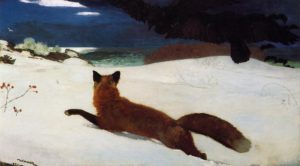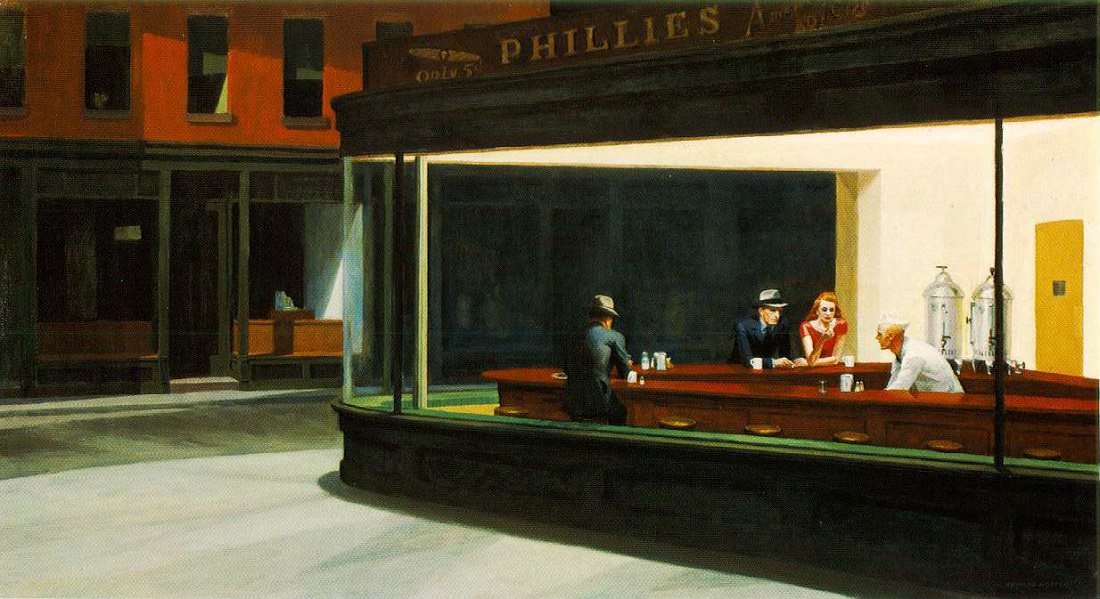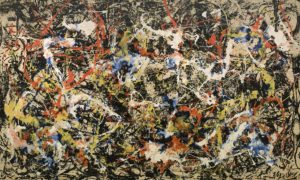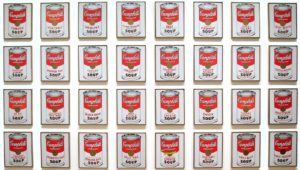___________________________________________________________________________________________________________________________
 Fox Hunt (1893) – Winslow Homer
Fox Hunt (1893) – Winslow Homer
The Fox Hunt was painted in Homer’s studio at Prouts Neck, Maine during the winter of 1893. The overall view of The Fox Hunt was that it was a Darwinian painting, portraying survival of the fittest. The fox is hunting for food, who is in turn being hunted by birds of prey, crows who are also driven by hunger. Several writers interpreted the fox as Homer’s self-portrait, resembling the small, inquisitive, and shrewd qualities of the fox. It is possible that Homer identified with the fox’s social aloofness and shyness as well.
The scene is mid-winter, along the New England coast. The center figure, the fox, is shown to be struggling through the heavy drifts of snow, looking for food. The fox seems aware of a flock of black crows, hovering and circling, also looking for food. In Maine, it is natural for flocks of starving crows, to actually attack a fox as food after a long winter. The crows rely on their large numbers and the weakened condition of the fox. The fox seems at a disadvantage in the painting, as it is slow to advance in the deep snow, making it very vulnerable and difficult to defend himself in the vast landscape of white snow.
Winslow Homer used a fox’s pelt, supplied by a friend who was a hunter, and draped it over a barrel in the snow at his studio, to accurately paint the colors of the fox. He also was supplied with crows, which he strategically placed, but found with the warming temperatures, became limp. He instead scattered corn on the ground to attract live crows, and sketched them, as a reference to be repainted in The Fox Hunt. The largest of his paintings, The Fox Hunt is still displayed today at the Pennsylvania Academy of the Fine Arts.
Source: http://totallyhistory.com/the-fox-hunt/
___________________________________________________________________________________________________________________________
 Nighthawks (1942) by Edward Hopper
Nighthawks (1942) by Edward Hopper
This artwork was created by Edward Hopper in 1942. The painting portrays people sitting in a downtown diner late at night. It is considered Hopper’s most famous work and is one of the most recognizable paintings in American art. One of the key features in this painting is the fluorescent lighting. The painting captures this new invention in its infancy. The fluorescence creates an eerie atmosphere which adds to the dark and lonely tone. Hopper’s image contains no known story line, making it universal. He wanted to depict the nightlife and how lonely it can be in a big city like New York. The four individuals portray the seclusion of people because of their lack of interaction. Art historians speculate that Hopper may have been inspired by Cafe Terrace at Night by Vincent van Gogh. The painting was sold to the Art Institute of Chicago for $3,000 within three months of being put up for sale. It has remained at the Institute ever since.
Source: http://www.artic.edu/aic/collections/artwork/111628
___________________________________________________________________________________________________________________________

Convergence (1953) by Jackson Pollock
This painting is considered by art historians to be one of his most famous works. This work which was a collage of colors splattered on a canvas that created masterful shapes and lines that evoke emotions and attack the eye. The painting was created in 1952, and is oil on canvas. This painting showcases Pollock’s masterful use of brushstrokes to accent certain colors, lines, textures, lights, and contrasting shapes. In 1964, puzzle producing company, Springbok Editions, released Convergence (Inspired by Pollock’s painting) the jigsaw puzzle. It was a 340-piece puzzle that they promoted as “the world’s most difficult puzzle”.
The impact of Pollock’s Convergence was evident in 1965 when hundreds of thousands of Americans purchased the jigsaw puzzle. Jackson Pollock’s style of painting, as exemplified by Convergence, is an important, innovative development in the history of painting. At the time of the painting, the United States took very seriously the threat of Communism and the cold war with Russia. Convergence was the embodiment of free speech and freedom of expression. Pollock threw mud in the face of convention and rebelled against the constraints of societies oppressions. It was everything that America stood for all rapped up in a messy, but deep package. Pollock’s abstract work was hard to decipher, but his rebellious nature and expressions of freedom were clearly evident.
Source: https://www.jackson-pollock.org/convergence.jsp
___________________________________________________________________________________________________________________________
 Campbell’s Soup Cans (1962) by Andy Warhol
Campbell’s Soup Cans (1962) by Andy Warhol
Campbell’s Soup Cans by Andy Warhol was also known as the 32 Campbell’s Soup Cans. The individual paintings by Warhol were made by a print-making method with the use of semi-mechanized tool for screen printing and a non-painterly style. The painting is based form the popular culture that helped to establish pop art as one of the largest art movements in the United States.
Warhol was a famous author, painter, film director and publisher. His one-man gallery exhibit in 1962 has helped him gain massive success as an artist. The gallery exhibition was held at the Ferus Gallery, which was located at Los Angeles, California. In fact, with this remarkable exhibit, he bolstered the fame of pop art in the United States. With the combination of non-painterly style and semi-mechanized tools in producing the images, he was able to create commercial-quality images of mundane objects. Moreover, his works have become a direct affront to abstract expressionism, which was popular during his era.
The artist produced an extensive variety of artworks that depicted Campbell’s soup cans, which were all made during the three significant phases of Warhol’s career. He also produced more artworks by using a number of images from the interesting world of mass media and commerce. At present, the theme depicted in the Campbell’s Soup Cans painting is used to refer the original set of artworks and later drawings of Warhol, which depicted this image. With the popularity of his paintings with similar themes, he earned a reputation not only as a remarkable pop art artist in the world, but also as the highest-priced American artist.
Source: https://www.moma.org/collection/works/79809
___________________________________________________________________________________________________________________________